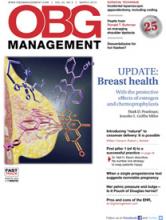“MOTHER-, BABY-, AND FAMILY-CENTERED CESAREAN DELIVERY: IT IS POSSIBLE”
WILLIAM CAMANN, MD, AND ROBERT L. BARBIERI, MD (EDITORIAL; MARCH 2013)
Skin-to-skin cesarean delivery means a lot to patients
I am a childbirth educator at Wentworth-Douglass Hospital in Dover, New Hampshire. I am also one of the childbirth education coordinators at the hospital. We have had a protocol for skin-to-skin cesarean delivery for about a year. This is an issue that I feel very strongly about. I have had emails from past patients saying how much having their babies “skin to skin” after cesarean delivery has meant to them. The research showing benefits of skin-to-skin contact after delivery is strong.
I also teach for Isis Parenting and have been encouraging my students to ask for skin to skin in the OR as well. I’m so encouraged to see Dr. Camann and Dr. Barbieri exploring the possibility of making skin to skin possible in the OR for families in the Boston area.
Another video showing the benefits of skin to skin focuses on breastfeeding. It’s called “Breast is Best” and can be viewed at http://www.youtube.com/watch?v=Cuu8UEXzVQ0.
Stacy Swain
Dover, New Hampshire
Family-centered cesareans draw families from afar
We have been offering family-centered cesareans for 1 year now. We call it the gentle cesarean. The baby is taken from the obstetrician and placed skin to skin with the mother. We have noticed that, when left skin to skin, these babies often self-attach and begin to breastfeed as the surgery is completed. Mother, father, and baby leave the OR and go to the obstetric postanesthesia care unit. We have had no complications, only happy patients and families. We have also noticed that people are driving past many other hospitals just to have their cesarean with us because we offer this practice.
Nancy J. Travis, RN, BC, CPN, BSN, MS
Cape Coral, Florida
Dr. Barbieri responds: Cooperation between team members leads to the best outcomes
We appreciate the video link provided by Ms. Swain and the report from Ms. Travis on the success of patient-centered cesarean delivery in her hospital. In our birthing unit, we greatly value the clinical care and program leadership provided by our childbirth educators, doulas, obstetric nurses, and nurse midwives, who have long championed patient-, baby- and family-centered care. The clinical leadership of our doulas, obstetric nurses, and nurse midwives is critical to continuously improve the care we provide. If we always work together as a team, we will achieve the best outcomes for our patients and their families.
“THE NATURAL HISTORY OF OBSTETRIC BRACHIAL PLEXUS INJURY”
ROBERT L. BARBIERI, MD (EDITORIAL; FEBRUARY 2013)
Extra caution is warranted in cases of shoulder dystocia
I enjoyed Dr. Barbieri’s editorial about obstetric brachial plexus injury (OBPI). I have an additional suggestion to reduce the incidence of this injury.
When faced with a significant shoulder dystocia, I exercise extra caution when applying the McRoberts maneuver and gentle downward pressure of the fetal head simultaneously, as the rotation of the symphysis pubis (and the fetal shoulder) in a cephalic fashion, in concert with forces that keep the fetal head static, may inadvertently cause further “stretch” to the brachial plexus. If initial attempts to apply gentle downward pressure to the fetal head do not relieve the dystocia, I take a quick break to catch my breath and remove my hands from the area, to allow my assistants to rotate the maternal pelvis via the McRoberts maneuver. I then resume attempts to relieve the shoulder dystocia by delivering the posterior arm or performing rotational maneuvers.
Andrea Shields, MD
Dayton, Ohio
The axillae can tell you whether dystocia is present
At vaginal delivery we strive to avoid fetal asphyxia and brachial plexus injury. After delivery of the fetal head, we refrain from pulling on the head, as this could strain the brachial plexus. Rather, we insert a finger into the vagina to identify the fetal axillae, first anteriorly and then posteriorly. If we cannot touch the anterior fetal axilla, that means it is lodged high behind the maternal pubis. At this point, we consider internal rotation of the fetal shoulder or suprapubic pressure. If the posterior axilla is palpable, it can be hooked with a fingertip, and gentle traction applied, to bring the posterior shoulder deeper into the pelvis, and this often dislodges the anterior shoulder. Of course, if a fetal hand is encountered posteriorly, it can be delivered, also permitting descent of the anterior shoulder. If neither anterior nor posterior fetal axilla can be palpated, then the shoulders are both outside the pelvis, and the fetal head should be pushed back into the vagina preparatory to cesarean delivery.


